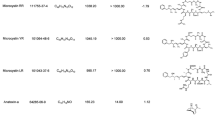Abstract
An analytical method based on high performance liquid chromatography tandem mass spectrometry (HPLC–MS/MS) has been developed to investigate florfenicol residues. Among 11 stations, florfenicol was detected in six water samples. The concentrations of florfenicol in the six samples were 64.2 μg L−1, 390.6 μg L−1, 1.1 × 104 μg L−1, 29.8 μg L−1, 61.6 μg L−1, 34.9 μg L−1, respectively. These results showed that high levels of florfenicol were observed in water samples collected from stations influenced by aquaculture discharges. However, no florfenicol residue was detected in the sediment samples. Furthermore, the functional diversities of microbial community in four marine sediment samples were analyzed by Biolog microplate. For the sediment samples from the stations where antibacterials had been used, the functional diversity of microbial community was much lower than those from the stations where antibacterials were not used.


Similar content being viewed by others
References
Babich E, Stotzky G (1983) Developing standard for environmental toxicants: the need to consider abiotic environmental factors and microbe mediated ecological processes. Environ Health Perspect 49:247–260
Baquero F (2001) Low-level antibacterial resistance: a gateway to clinical resistance. Drug Resist Updat 4:93–105. doi:10.1054/drup.2001.0196
Boxall ABA, Fogg LA, Baird DJ, Lewis C, Telfer TC, Kolpin D, Gravell A, Pemberton E, Boucard T (2005) Targeted monitoring study for veterinary medicines in the environment. Science Report SC030183/SR. UK Environment Agency, Bristol
Briggs GG (1981) Theoretical and experimental relationships between soil adsorption, octanol water partition coefficients, coefficients, water solubilities, bioconcentration factors, and the parachor. Agri Food Chem 29:1050–1059
Buyer JS, Roberts DP, Millner P, Russek-Cohen E (2001) Analysis of fungal communities by sole carbon source utilization profiles. J Microbiol Methods 45:53–60
Díaz-Cruz MS, López de Alda MJ, Barceló D (2003) Environmental behavior and analysis of veterinary and human drugs in soils, sediments and sludge. Trends Anal Chem 22:340–351. doi:10.1016/S0165-9936(03)00603-4
Gamo M, Shoji T (1999) A method of profiling microbial communities based on a most-probable-number assay that use BIOLOG plates and multiple sole carbon sources. Appl Environ Microbiol 65:4419–4424
Garland JL, Mills AL (1991) Classification and characterization of heterotrophic microbial communities on the basis of patterns of community-level sole carbon-source utilization. Appl Environ Microbiol 57:2351–2359
Grove JA, Kautola H, Javadpour S, Moo-Young M, Anderson WA (2004) Assessment of changes in the microorganism community in a biofilter. Biochem Eng J 18:111–114. doi:10.1016/S1369-703X(03)00182-7
Herwig RP, Gray JP, Weston DP (1997) Antibacterials resistant bacteria in surficial sediments near salmon net-cages farms in Puget Sound, Washington. Aquaculture 149:263–283
Hu JT, Zong HM, Wang JY, Ma DY (2007) The effect of environmental factors on the degradation of florfenicol in marine sediment. China Environmental Science 27:748–751 (in Chinese)
Kim Y, Jung J, Kimb M, Park J, Boxall ABA, Choi K (2008) Prioritizing veterinary pharmaceuticals for aquatic environment in Korea. Environ Toxicol Pharmacol 26:167–176. doi:10.1016/j.etap.2008.03.006
Kong WD, Zhu YG, Fu BJ, Marschner P, He JZ (2006) The veterinary antibiotic oxytetracycline and Cu influence functional diversity of the soil microbial community. Environ Pollut 143:129–137. doi:10.1016/j.envpol.2005.11.003
Lai HT, H JH, Su CI, Chen CL (2009) Effects of chloramphenicol, florfenicol, and thiamphenicol on growth of algae Chlorella pyrenoidosa, Isochrysis galbana, and Tetraselmis chui. Ecotoxicol Environ Saf 72:329–334. doi:10.1016/j.ecoenv.2008.03.005
Li ZP, Wu XC, Chen BY (2007) Changes in transformation of soil organic C and functional diversity of soil microbial community under different land uses. Agricultural Sciences in China 6:1235–1245
Lin RY, Rong H, Zhou JJ, Yu CP, Ye CY, Chen LS, Lin WX (2007) Impact of allelopathic rice seedlings on rhizospheric microbial populations and their functional diversity. Acta Ecologica Sinica 27:3644–3654
Lundén T, Lilius EM, Bylund G (2002) Respiratory burst activity of rainbow trout (Oncorhynchus mykiss) phagocytes is modulated by antimicrobial drugs. Aquaculture 207:203–212
Ma DY, Hu YY, Wang JY, Ye S, Li A (2006) Effects of antibactericals use in aquaculture on biogeochemical processes in marine sediment. Sci Total Environ 367:273–277. doi:10.1016/j.scitotenv.2005.10.014
Matyar F, Kaya A, Dinçer S (2008) Antibacterial agents and heavy metal resistance in Gram-negative bacteria isolated from seawater, shrimp and sediment in Iskenderun Bay, Turkey. Sci Total Environ 407:279–285. doi:10.1016/j.scitotenv.2008.08.014
Miranda CD, Zemelmanb R (2002) Antimicrobial multiresistance in bacteria isolated from freshwater Chilean salmon farms. Sci Total Environ 293:207–218
Rigos G, Nengas I, Alexis M, Troisi GM (2004) Potential drug (oxytetracycline and oxolinic acid) pollution from Mediterranean sparid fish farms. Aquat Toxicol 69:281–288. doi:10.1016/j.aquatox.2004.05.009
Samuelsen O, Bergh Ø (2004) Efficacy of orally administered florfenicol and oxolinic acid for the treatment of vibriosis in cod (Gadus morhua). Aquaculture 235:27–35. doi:10.1016/S0044-8486(03)00446-0
Wollenberger L, Halling-Sørensen B, Kusk KO (2000) Acute and chronic toxicity of veterinary antibiotics to daphnia magna. Chemosphere 40:723–730
Ye S, Yao ZW, Na GS, Wang JY, Ma DY (2007) Rapid simultaneous determination of 14 sulfonamides in wastewater by liquid chromatography tandem mass spectrometry. J Sep Sci 30:2360–2369. doi:10.1002/jssc.200600539
Zong HM, Ma DY, Wang JY, Hu JT (2008) Effects of florfenicol on microbial activity in marine sediment. Chin J Appl Environ Biol 14:408–412 (in Chinese)
Acknowledgment
The financial support by National Natural Science Foundation of the People’s Republic of China (No. 40576051).
Author information
Authors and Affiliations
Corresponding author
Rights and permissions
About this article
Cite this article
Zong, H., Ma, D., Wang, J. et al. Research on Florfenicol Residue in Coastal Area of Dalian (Northern China) and Analysis of Functional Diversity of the Microbial Community in Marine Sediment. Bull Environ Contam Toxicol 84, 245–249 (2010). https://doi.org/10.1007/s00128-009-9923-1
Received:
Accepted:
Published:
Issue Date:
DOI: https://doi.org/10.1007/s00128-009-9923-1




